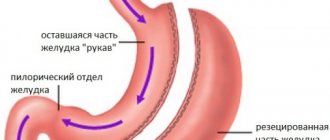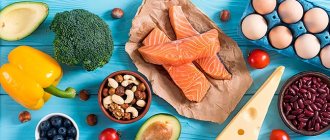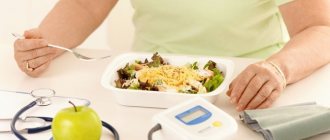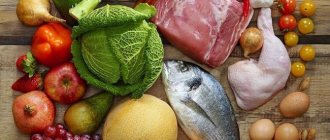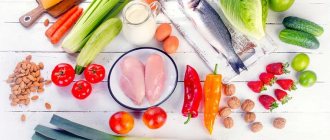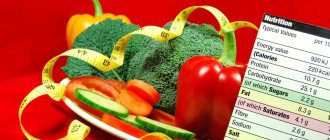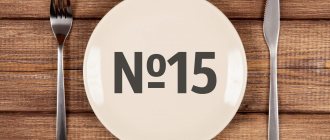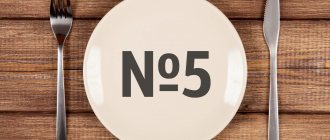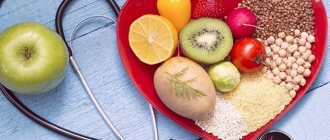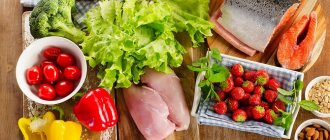In the twentieth century in Russia, gastroenterologist Professor Manuil Pevzner studied the influence of human diet to alleviate the course and treatment of various diseases. The result of many years of painstaking work was the creation of a series of therapeutic diets consisting of specially designed 15 tables. Each of the diets is intended for therapeutic nutrition of the patient depending on the disease and helps to quickly restore the body’s functioning.
The fifth diet is prescribed for liver diseases, impaired secretion of the digestive glands, and problems with the biliary tract. At different stages of diseases and complications, the composition of the diet may change. We’ll talk more about diet options No. 5, how to follow them, and the list of allowed and prohibited foods below.
Table number 5
The fifth table is a food system, which consists of a list of dishes, regime, and rules for processing food. Can be used in both adults and children. Its main goal is to improve and restore the functioning of the liver and biliary tract. In this regard, the indications for prescribing diet No. 5 are: chronic cholecystitis, liver cirrhosis (without decompensation), chronic hepatitis, liver steatosis. In addition, it is prescribed for 14-17 days after removal of the gallbladder. Also, table No. 5 can be used for mild toxicosis during pregnancy.
Diet 5 is applicable only in cases of chronic diseases outside of exacerbation and during periods of recovery. The use of this treatment table is contraindicated during periods of exacerbation of diseases and existing complications, as well as with concomitant gastritis or ulcers.
Content:
- Table number 5
- Therapeutic diet
- Menu for table No. 5
- Table number 5a
- Table number 5b
- Table number 5p
The diet is prescribed for a long time. At first it is prescribed for about a week with constant monitoring of the patient. If the nutritional system is tolerated normally, the course is extended. The duration of a therapeutic nutrition program is most often one and a half years and depends on the dynamics of the disease. Also, the prescribed diet No. 5 can be replaced or adjusted during this period.
A diet that includes table 5 is most often prescribed to patients with impaired liver and gallbladder function. Such nutrition improves the functions of these organs, and also normalizes metabolism and the digestion process. The program has a beneficial effect on almost all internal organs and can serve as a prevention of other diseases.
The main therapeutic effect on the liver, gall bladder and biliary tract is provided by three sparing factors. That is, the food taken should be gentle in chemical composition and mechanical processing. The temperature of the food you eat is also important.
Chemical composition. The main objective of diet No. 5 is to provide the patient with adequate nutrition, while excluding those foods that impair the functioning of the liver and gall bladder. For hepatitis, cirrhosis and cholecystitis, it is forbidden to eat foods high in cholesterol, fats, and essential oils. It is important to ensure that every day the patient consumes all the necessary components: proteins, carbohydrates, fats in small quantities. Salt is limited to 10 g per day. Table No. 5 is completely balanced and involves consuming 2500 kcal per day. For pregnant women, the daily calorie content should be at least 2800 kcal.
Diet No. 5 requires compliance with the temperature regime of the food consumed in the range from 20 to 60 degrees. Cold and too hot dishes are undesirable for diseases of the liver and bile ducts.
Mechanical processing is the grinding of food, which is necessary to facilitate the digestion process. For the fifth table, it is not necessary to chop or grind everything; a lot can be eaten in whole pieces. Vegetables with a high fiber content must be chopped: finely chopped, grated, boiled - grated through cheesecloth. The same goes for stringy meat.
Dietary dishes can be baked, boiled in milk or water, or steamed. Twice a week you can eat stew: vegetable stew, roast from minced meat, dietary cocotte. It is forbidden to eat fried foods, as such food contains fat oxidation products, which impede the production of bile, thereby impairing liver function. You need to eat often - at least 5 times a day, in medium portions.
Let's take a closer look at what the diet for a patient on the fifth diet may consist of.
Nutrition for acute cholecystitis: basic rules
In acute cholecystitis, you need to follow proper nutrition.
Based on the stage or severity of the disease, the specialist draws up a specific diet plan for each patient. In this case, it is necessary to follow the general principles of eating food for this disease:
- Divide the daily food intake into 5-6 parts - such nutrition will have a positive effect on the functionality of the gallbladder;
- eat regularly at certain hours - this will gradually lead to proper production of bile;
- increase fluid intake to 2–2.5 liters per day - will help remove bile and harmful products from the body in a short time;
- completely abandon alcohol-containing drinks - alcohol can cause the development of hepatic colic or the appearance of stones;
- reduce the amount of salt - will prevent stagnation of bile;
- the temperature of consumed products should be within 15-60C;
- do not forcefully eat food - such violence against the body will not have a positive effect, but will only adversely affect the production of bile.
Food should bring not only benefits, but also pleasure. This can be achieved if you set the table beautifully and start eating in a good mood or pleasant company. This is an important part of getting rid of acute cholecystitis.
Therapeutic diet
The list of permitted products is quite wide.
Restrictions apply only to fatty, spicy, salty and fermented foods, because such food increases the secretion of digestive juices of the pancreas and irritates the gastric mucosa. Below is a list of foods that should be limited or completely eliminated. Table ration number 5
| Group | Allowed | Forbidden |
| First |
|
|
| Vegetables |
|
|
| Meat |
|
|
| Fish and seafood |
|
|
| Flour |
|
|
| Cereals |
|
|
| Milk products |
|
|
| Eggs |
|
|
| Berries and fruits |
|
|
| Dessert |
|
|
| Beverages |
|
|
Having a list of acceptable dishes and products, you can create therapeutic nutrition. It is recommended to prepare the menu in advance, at least 2 days in advance. This way you can stock up on the necessary products and select recipes, and preparing dishes will take less time. Exact adherence to all diet rules will protect against exacerbation of the disease and speed up recovery.
Meat salad with seaweed for dietary nutrition
To prepare meat salad with seaweed we will need the following products:
- One can of canned seaweed,
- Pre-boiled lean pork or veal meat,
- Boiled potatoes,
- Cucumbers and apples.
- Don't forget to buy a can of green peas, sour milk and sour cream. You can buy lightly salted cucumbers in the store, or pickle them yourself. If you pickle the cucumbers yourself, you can first read the article on how to properly pickle cucumbers at home.
Preparation:
- So, all the ingredients are assembled, you can start preparing the salad.
- Vegetables are washed thoroughly in running water.
- Boiled meat and potatoes, cucumbers and apples are cut into small strips and mixed with canned (or fresh) peas and seaweed.
- The resulting mass is poured with a mixture of vegetable oil, sour cream and curdled milk (see proportions below), placed in a salad bowl and sprinkled with herbs to taste.
- If you like dishes with seaweed, then you will most likely like this dietary meat salad. Bon appetit!
Menu for table No. 5
To make it easier to create your diet, you can consider a ready-made sample menu and recipes for it.
The first day
Breakfast: milk oatmeal with pureed dried fruits, tea.
Lunch: pureed low-fat cottage cheese, tea.
Lunch: beetroot soup, 10 g sour cream, buckwheat with meatballs, bread.
Dinner: baked zucchini pancakes, a little sour cream 10% fat.
Second day
Breakfast: semolina pudding, tea with milk.
Lunch: wheat bread toast, sour jam or jam, black tea.
Lunch: dietary cabbage soup, bread.
Dinner: buckwheat groats, berry compote.
Buckwheat: boil 200 g of buckwheat well in a large amount of water. Grate 200 g of cottage cheese, add to it a tablespoon of sugar, 100 ml of milk and one egg (mix everything). Combine the porridge and curd mass and bake under foil until fully cooked.
Day three
Breakfast: steamed carrot pancakes, tea.
Lunch: dry cookies, dried fruit compote.
Lunch: pearl barley soup, a little sour cream, bread.
Dinner: steamed chicken dumplings, boiled cauliflower.
Day four
Breakfast: semolina casserole, weak black tea.
Casserole: cook viscous semolina porridge and cool it (200 g of cereal). Add one and a half eggs, sugar, raisins or chopped prunes to the semolina. Beat everything well and bake in a greased pan until done.
Lunch: dry biscuit, fruit compote.
Lunch: soup with rice and vegetables, separately boiled chicken.
Dinner: boiled couscous with raisins, chamomile or rosehip infusion.
Day five
Breakfast: oatmeal with milk, tea.
Lunch: salad of cucumbers, lettuce and carrots.
Lunch: dietary borscht, sour cream, bread.
Dinner: vegetable stew, a piece of boiled lean beef.
Day six
Breakfast: baked pears with honey, tea.
Lunch: wheat toast with mashed cottage cheese.
Lunch: milk noodle soup.
Dinner: mashed potatoes, meatballs stewed in sour cream, rosehip broth.
Day seven
Breakfast: protein omelet with boiled green beans, tea.
Lunch: salad of dried apricots and grated carrots.
Lunch: soup with oatmeal, carrots and potatoes, bread.
Dinner: meat soufflé, rye bread toast, chamomile infusion.
Meat soufflé: mince 200 g of boiled beef twice and mix with 1 yolk. Pour 100 ml of milk into the minced meat and mix. Beat 2 egg whites into a thick foam and carefully mix them with the meat. Steam the soufflé.
Based on appetite, you can add snacks, second breakfast and afternoon snack. This is a sample menu for the week; you can make your own adjustments to it or come up with your own personal recipes. The main thing is not to deviate from the rules: eat only warm food from permitted ingredients in small portions.
Sauces
It’s hard to imagine almost any salad, casserole or meat dish without dressing. However, dietary table No. 5 does not involve the use of hot, fatty and sour sauces. However, this does not mean that a person should eat tasteless food. It can and should be seasoned, for which you should use the recipes below for sauces allowed on diet No. 5.
Milk sauce
This sauce is an excellent addition to various desserts: puddings, pancakes, casseroles, cookies. To prepare it you will need 50 ml of water and milk, 10 g of butter, a teaspoon of sugar and flour, and a pinch of vanillin.
Dry the flour in a frying pan, add butter to it and grind until a homogeneous mass is obtained. Then it is mixed with milk, brought to a boil, boiled for 10 minutes, sugar and vanillin diluted in water are added. The resulting sauce should be filtered, cooled and used as a dressing for desserts.
Applesauce
This sauce is great for cereals, cottage cheese, pasta, and casseroles. To prepare it you will need 2 apples, starch (30 g), sugar (150 g), a gram of cinnamon and a couple of drops of lemon juice.
Apples need to be peeled and seeded, cut into small slices, put in a saucepan, add sugar and lemon juice, add cold water and boil. When the apples become soft, they are passed through a sieve, mixed with water again and brought to a boil. The starch is dissolved in water and added to the apple sauce, stirring constantly. Then add cinnamon there.
Author of the article:
Kuzmina Vera Valerievna |
Endocrinologist, nutritionist Education: Diploma of the Russian State Medical University named after. N.I. Pirogov, specialty “General Medicine” (2004). Residency at the Moscow State Medical and Dental University, diploma in Endocrinology (2006). Our authors
Table number 5a
Diet 5a according to Pevzner is prescribed during periods of exacerbation of pancreatitis, cholecystitis, and cholelithiasis. It is used in cases of combination of these diseases with gastritis and peptic ulcer. The diet ensures maximum rest for the liver and gall bladder, spares the gastrointestinal tract, and facilitates the functioning of the bile ducts.
This diet option differs from the fifth table in even greater mechanical and chemical sparing. All dishes should be soft, pureed, slimy and mushy. The list of products remains the same, only with greater restrictions.
Soups should be light, with finely chopped or grated vegetables and pureed cereals. You can add boiled vermicelli and a little milk to them. Types with a high fiber content are excluded from fruits and vegetables; the consumption of quince and pear, as well as all varieties of cabbage, is not recommended.
Millet is prohibited from cereals. It is also not recommended to consume veal and young chickens. As for bakery products, it is preferable to eat no more than three pieces per day of dried bread made from second-grade flour. Desserts and drinks remain the same as in the previous version.
The menu for table 5a will consist of cereals, boiled vegetables, mashed potatoes (potatoes, meat) and vegetarian soups. You can prepare souffles, jelly, jellies, puddings, steamed cutlets and meatballs. It is important to eat the necessary proteins, fats and carbohydrates every day. It is forbidden to go hungry or eat too much.
Table 5a is prescribed until improvement occurs, then switches to another diet. It is strictly not recommended to independently adjust the diet during exacerbations of diseases.
Giving up the diet
Failure to follow a diet for cholecystitis can lead to the development of pancreatitis.
Failure to follow the diet can result in the following unpleasant “surprises”:
- gallstones;
- pancreatitis;
- dropsy or suppuration in the gallbladder;
- hepatic colic;
- gangrene or abscess of the gallbladder;
- diffuse peritonitis;
- perforation of the gallbladder;
- jaundice.
Almost all of the listed complications can lead to the operating table.
Table number 5b
In the treatment of chronic pancreatitis against the background of drug therapy, diet No. 5b (or 5 p31) is used. This option is used in patients at the recovery stage after an attack of acute pancreatitis or in the remission phase after an exacerbation of chronic pancreatitis. The list of products remains the same as for table 5a. The food served should be warm and well chopped. The main restrictions concern fatty foods and sugar, which is replaced with sweeteners, preferably stevia.
The following are strictly prohibited: alcoholic and carbonated drinks, caffeine, sweets, flour (except for dried wheat bread), smoked foods, fried foods, pickles, raw fruits and vegetables. Low-fat dairy products are added to dishes; pureed cottage cheese is allowed (preferably calcined).
The diet consists of 6-7 meals, in small portions. The patient should eat a little food every 3-3.5 hours. Per day - approximately 1500 kcal. Everything is boiled, steamed or baked without crust while warm. Salt is limited (8 g per day).
The rest of the rules remain the same, as in previous versions of table No. 5. The main difference is more frequent meals and increased mechanical sparing. This option can be used for patients with concomitant chronic gastritis.
Cabbage salad with celery
To prepare the salad you will need:
- cabbage (100 g),
- celery (50 g),
- one apple,
- half a teaspoon of sugar and 1.5 tablespoons of sour cream.
Preparation:
- The cabbage should be washed well, finely chopped, salted and squeezed.
- The resulting juice is drained.
- The apple is peeled and seeded and cut into slices.
- Celery is cut into strips.
- Then all the ingredients for the salad are mixed, sugar and sour cream are added to them.
- The salad is placed in a heap in a salad bowl.
Quick pollock soup
Ingredients:
- Pollock fillet – 150-200 gr.
- Carrots – 1 pc. (small)
- Potatoes – 1 pc. (large)
- Water – 300 ml
- Chopped dill on the tip of a knife - optional
- Salt - a pinch
Cooking method:
Cut the pollock fillet into medium-sized pieces. Let's cook. At the same time, cut the potatoes and carrots and add them to cook in a separate bowl. Once the fish is cooked, turn off the heat. Keep in mind: we do not use broth from it.
When the potatoes and carrots are cooked, throw in the pieces of pollock taken out of the broth. Warm up the soup and let it brew for ten minutes. If desired, during cooking (but not when serving), you can add a pinch of chopped dill to the soup.
